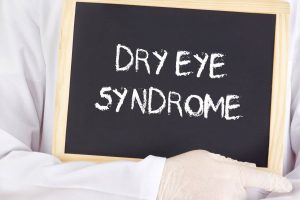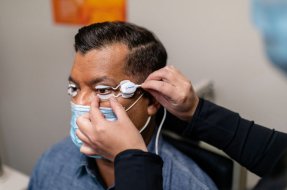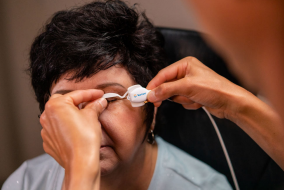
Dry eye syndrome (DES) is a chronic condition that develops when your eyes do not produce and maintain enough tears to keep the eye’s surface lubricated resulting in multiple symptoms that range from person to person. This can be due to a reduction in tear production or increased tear evaporation from a lack of lipid in the tears that stem from oil glands in the eyelids. The effects can range from minor dryness and discomfort to pain, blurred vision and frequent infections.
The main function of tears is to maintain the health of the cornea of your eye by washing away foreign matter and ensuring that the surface of your eye remains moist, smooth and clear. Tears also rinse away dust particles from your eyes and contain enzymes that protect your eyes from bacteria that can cause infections. Dry eyes is a condition that develops when the amount of tears produced or the quality of the tears is not adequate to maintain the moisture balance in your eye. This can result in that scratchy sensation, a continuous feeling of dryness, stinging and a sensation of a foreign body in your eye. Ironically in an effort to fight off the condition, dry eyes can cause you to produce excessive tears, which is why some people experience watery eyes.
Symptoms of Dry Eye Disease
Symptoms of dry eye syndrome can vary depending on the severity of the condition but can include:
- Dry, itchy eyes

- Burning or stinging
- Irritation
- Watery eyes
- Blurred vision
- Pain
- Foreign body sensation
What causes Dry Eye?
Dry eye can be influenced by a number of factors related to environment and health that determine tear quality. Tears have 3 layers: • a mucus layer, • an aqueous (watery) layer, and • a lipid (oily) layer. If there’s an imbalance in these layers, your vision and comfort of your eyes may be affected.
For example, if not enough lipid layer is being produced, tears may evaporate too quickly and cause symptoms ranging from discomfort to extra tear production and poor quality of vision. Poor tear quality is often caused by Meibomian Gland Dysfunction (MGD), a condition that impacts the production of oils in your tears. The most common form of MGD is obstruction of the oil producing glands in the eyelids.
At Bright Side Eye Care, we will test your tear quality to determine whether MGD is contributing to or causing your dry eye symptoms and create a customized treatment plan to address it.


Diagnosis of Dry Eye Disease
Typically, dry eye disease can be diagnosed through a comprehensive eye exam and a description of your symptoms. On some occasions the eye doctor might decide to do a test that measures how quickly your tears evaporate from the surface of your eye. By instilling a simple dye called fluorescein (much like food coloring) the doctor is able to watch and count how long it takes the tears to start to break up after they’ve asked you to hold your eyes open after a blink. This is called TBUT or a Tear Break Up Time test. A low TBUT generally indicates a lipid (aka oil) deficiency in the tears resulting from oil glands in the eyelids not functioning properly. We can also image your oil glands, using a meibographer, to help determine if the quality of your oil production is sufficient.
How do we treat Dry Eye?
Each case of Dry Eye is unique. We consider the factors causing your dry eye as well as your tear quality to develop a custom dry eye treatment plan. Management considerations for Dry Eye include artificial tears/lubricant drops which provide short-term relief of symptoms. Other options include prescription anti-inflammatory drops and Meibomian glad therapy with medical devices like The TearCare® System and/ or Intense Pulsed Light (IPL) treatments. For more information on IPL see our Aesthetic Services page.



Preventing Dry Eyes
If the cause of your dry eyes is something external or environmental, eliminating that cause may solve the problem and resolve the symptoms. Avoid dry environments, hair dryers, heaters and fans, (particularly directed toward the eyes) and smoky environments and wear eye protection such as wrap around glasses or goggles when in dusty or windy areas. Use a humidifier to add moisture to dry indoor air. If working on computer or watching television, make sure to blink purposefully as our natural tendency is to reduce our blink rate when staring at a screen. Also avoid rubbing your eyes as this can further irritate them. Staying hydrated by drinking at least 8 to 10 glasses of water per day can also help.
Dry eye disease can adversely affect vision and quality of life. There is no reason to endure dry, itchy and uncomfortable eyes, especially since with so many treatment options to increase moisture and comfort. It’s also important to realize that this is a chronic disease that needs consistent treatment. Dr. Iranpour will work with you to create a long term strategy to keep your eyes as comfortable and healthy as possible.


Note: Saturday By Appointment Only